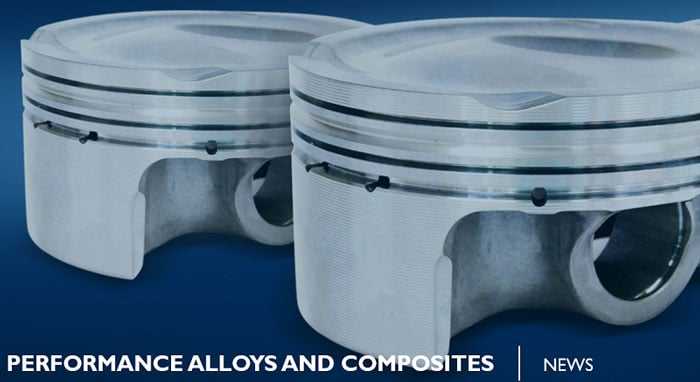
Since the invention of our SupremEX® metal matrix composite (MMC) and its successful run as pistons in Formula 1 racing, engine designers worldwide have recognized the material as a key to increased efficiency. To make the technology accessible to the broader automotive market, Materion’s Technology and Innovation experts have continued to develop ways to reduce cost and improve machinability. However, it took the pioneering engineers at Cosworth to design and implement pistons that fully demonstrate the material’s potential.
Using SupremEX MMCs allows automotive manufacturers to move away from the traditional metal billets, forgings and castings that are not suited to the demands of tomorrow’s high-performance engines.
Our SupremEX composite combines ultrafine silicon carbide reinforcement with aerospace aluminium alloys. The result is a composite that is superior to conventional alloys, combining the lightweight properties of aluminium with outstanding strength and stiffness. Higher working temperatures and combustion pressures can be achieved due to greater fatigue resistance, more than double that of conventional aluminium alloys at running temperatures. In addition, the lower coefficient of friction and increased wear resistance contribute to improved combustion efficiency, brake specific fuel consumption and hydro-carbon emissions.
Cosworth’s pistons made of our SupremEX MMC have already helped to deliver superlative performance in the all-new Gordon Murray Automotive T.50 supercar, which boasts a maximum speed of 12,000rpm and produces the highest specific output of any road going naturally aspirated engine at 166PS-per-litre.
Cosworth’s Managing Director of Powertrain, Bruce Wood said, “Cosworth has produced pistons for our own applications and customer projects for decades. We specialise in high-performance forged pistons for applications as diverse as our small, 2-stroke diesel drone engine to our current hypercar engines for Aston Martin and Gordon Murray Automotive. Every piston design needs to balance performance with durability, and we are delighted to be working with Materion to harness their unique material properties to push the boundaries of what we can deliver.”
These pistons are also an integral feature of the Lanzante TAG Turbo project. Eleven mid-80s F1 Turbocharged V6 engines have been shoehorned into the back of the very limited TAG 930s. The 1.5 litre engines secured nine podiums in the 1984 F1 season, including a win at Brands Hatch at the hands of Niki Lauda.
Lanzante reached out to Cosworth to rework the 1000hp+ V6 into a reliable, useable, road going engine. The result is 503hp and 420Nm of torque with a rev limit if 9,000rpm, making these extremely limited engines the highest revving turbocharged power units used in a road legal car. An unachievable feat without the development of the SupremEX MMC piston’s unique structure yielding high strength while remaining very lightweight.
The design changes that were enabled by SupremEX MMC to maximize engine performance in the Gordon Murray Automotive T.50 supercar and the Lanzante TAG Turbo project can also be used to increase engine efficiency. For example, pistons made with SupremEX MMC can be significantly lighter than those made with conventional materials. Reducing piston mass also has secondary effects that allow for reduction in mass elsewhere in the crank train. As leading Grand Prix engine designer, Louis Herve Coatalen, said over one hundred years ago, “an ounce off the piston is worth a pound off the crankshaft and a hundredweight (112 lb.) off the chassis.”
Learn more about Cosworth's use of high-performance alloys in racing applications in our whitepaper.